Henri Rousseau Biography
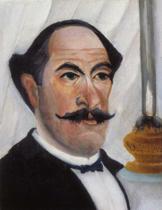
Henri Rousseau (1844-1910), nicknamed "Le Douanier" or "the customs man" after the job he worked before becoming an artist, was a Post-Impressionist painter of the late 19th Century. Although Rousseau sought to emulate academic traditions, his lack of formal training in the basics of composition and perspective gave his artwork a unique touch. The painter was a regular contributor to Paris exhibitions, but, during his lifetime, was viewed with amusement and condescension by both the public and fellow artists.
Henri Julien Felix Rousseau was born on May 21st, 1844, in the town of Laval in the North of France. His parents were Julien and Eleonore Rousseau. The family was part of a long line of petty bourgeoisie and the father owned several tin-ware shops. During the early years of his life, Henri was raised in relative prosperity, which made his parents' later financial woes affect him all the harder.
At the age of 5, little Henri was enrolled at the local elementary school, after completing which he entered the Laval lycee. Although the boy had demonstrated an inclination for art early on, it was not done for members of the bourgeoisie to pursue the unconventional and monetarily unrewarding vocation of painting, and there was no talk of giving the child an artistic education. Rousseau would often rue his parents' inability to recognize his talent in later years. However, had the bourgeois prosperity of the Rousseaus endured, it is doubtful that Henri would ever have taken up a career as a painter.
Disaster struck in 1851, when the father lost his business as a result of speculation. The family was forced out of their home and continued to move for the next several years. In order to conclude his education at the Laval lycee without interruption, Henri stayed on as a boarding pupil. Despite his later reputation as "naïve" and poorly-educated, he had a full 12 years of education and was reasonably well-educated by the standards of the time.
In 1861, the future painter re-joined his family and with them moved to Angers. At the time, France had a lottery system for conscripting soldiers, and Henri Rousseau managed to avoid getting drafted when he came of age. Instead, he found work as a clerk for a local soliciting firm.
In 1863, the young man was accused of stealing 20 francs from his employer: a sum of money equivalent to a few hundred modern-day US dollars. In order to avoid punishment, Henri ran away to enlist in the 51st infantry regiment of the French army for seven years' service. This, however, did not help and in 1864, he was sentenced to one month's imprisonment for his crime.
Rousseau's military service coincided with French military intervention in Mexico, which lasted from 1862 to 1867. Although men from the future artist's regiment took part in the conflict, Rousseau remained in France throughout his enlistment, despite his later claims to the contrary.
In 1868, Rousseau's father died and the future painter was discharged from the armed forces, 2 years early. He moved to Paris where he found employment as a bailiff's helper. In the following year, he married Clemence Boitard, the daughter of his landlord. In 1870, they had their first son, who died several months later. In total, out of the four children born to them, only one, Julia, born 1876, would survive to adulthood.
Soon after his marriage, in 1871, Rousseau got a job at the Paris Octroi, a government agency that taxed and collected tolls on goods being brought into Paris. The work was not terribly intense, mostly consisting of long periods of waiting for carts to arrive. It was probably these stretches of free time that stimulated Rousseau to take up painting. This was the job that would earn him the nickname "Douanier" within artistic circles.
Although no fixed date is documented, Henri Rousseau probably first took up the brush around the age of 40. He was encouraged in this pursuit by his next-door neighbor, the painter Felix Clement, who spotted Rousseau's unrefined talent. Through Clement, Rousseau obtained a license to make copies at the Louvre and other art galleries.
In 1884, Henri submitted his work to the official Salon, but was rejected. While executed possessing a degree of native talent and a fine eye for color, the painter had no formal education in art, and was ignorant of perspective and proportion, which imbued his paintings with a naïve, childish appearance. They were not considered good enough for the Salon.
Rousseau turned instead to the newly-established Salon des Independents, which welcomed all artists, irrelevant of skill and public opinion. His work was exhibited, for the first time, at the 1886 exhibition, the Independents' second ever. Rousseau showed his Carnival Evening (1886), which, with its complete disregard for the conventions of painting, amused critics and fellow artists. This was the beginning of Rousseau's career in art and, unfortunately, the attitude of those around him would change little over its course.
After this debut, the painter would participate in every one of the Independents' annual exhibitions between 1886 and 1910, except the ones of 1899 and 1900. This was an impressive record for any artist.
In 1888, Rousseau's wife Clemence died, affecting him deeply. He would make frequent mentions of this tragedy in his later correspondence and in conversation. On the other hand, he rarely spoke of his three dead children by Clemence and his one living daughter, Julia.
The painter's artwork of the late 1880s and early 1890s is dominated almost exclusively by landscapes, which were his trademark genre. He painted the wilderness, usually completely imaginary, as Rousseau rarely visited the country side, and Paris landscapes. The former usually feature solitary human figures or couples, and would later evolve into the exotic jungle landscapes that the painter is best known for. Examples include: Promenade in the Forest (1886) and Rendezvous in the Forest (1889). Parisian landscapes include: View of Saint-Louis Island Seen from the Port of Saint-Nicolas (1888), Toll Station (1889) and Myself, Portrait-Landscape (1890).
In the 1890s, there was growing interest within the European public for the exoticism of the tropics. The late 19th Century was the height of the colonial period. Nationalist independence movements in the countries of Africa and Asia were only just appearing. The darker aspects of colonialism had not yet been brought to public attention and Europeans were interested in knowing more about the vast overseas territories that they felt belonged to them.
Thus, Rousseau's jungle landscapes, the first of which, Tiger in a Tropical Storm (Surprised!), he exhibited in the 1891 Salon des Independants, found a receptive audience. Simultaneously, Paul Gauguin was visiting Tahiti while, across the Channel, British author Rudyard Kipling was publishing the first of his stories and poems about India. However, despite some critics' positive comments on the painting's subject matter, Rousseau was again ridiculed by those who saw his work as amateurish and, after this first painting, he abandoned the jungle landscape genre for some time.
In 1893, Rousseau asked for permission to retire from the Octroi early. His superiors and fellow workers had long supported him in his pursuit of art, freeing him of many of his duties and granting him time to paint during work hours. His resignation was accepted and Rousseau settled down to pursue painting full-time.
The artist tried his hand at monumental painting. He entered the competition for the decoration of the Bagnolet Town Hall, but his projects were rejected. In 1894, he finished the allegorical painting War, which he exhibited once again with the Salon des Independants. War, painted in Rousseau's usual simplistic, naïve style, depicts a warrior angel, armed with a sword and astride its horse, trampling mutilated bodies. The work was given a positive review by Rousseau's countryman and friend the writer and poet Alfred Jarry, also from Laval, although the latter was no unswerving fan of the painter. Jarry destroyed the portrait that Rousseau painted for him in 1895 because he could not stand it.
Rousseau's output of this period in his life includes a variety of genres, from portraits to still-lifes to landscapes. Some notable works are: A Centennial of Independence (1892), Artillerymen (1893-95), Portrait of a Woman (1895-97), Chair Factory (1897), Flowers (1895-1900) and Landscape with Cattle (1895-1900)
During all of the late 1890s, Rousseau continued to seek official patronage. In 1898, he offered the painting The Sleeping Gipsy, today widely considered to be one of his best works, to the mayor of Laval for a considerably sum of money. His offer was rejected. The same year, he submitted his plans for the decoration of the Vincennes Town Hall and was similarly rejected. Two years later, in 1900, he offered to paint the Asnieres Town Hall, but was once again unsuccessful.
In 1899, Rousseau married his second wife, the widow Josephine Noury. She would die only four short years later in 1903, leaving the artist heartbroken.
No longer employed at the Octroi, Rousseau soon began running into financial problems. He accumulated debts, which, though not very large, were more than he could pay off on his own. He found work part-time as a salesman for the magazine Le Petit Journal, and began to offer drawing lessons. Also around this time, he began to teach drawing and ceramic painting and eventually also music.
In 1904, Rousseau returned to the jungle genre with a series of paintings: Scouts Attacked by a Tiger (1904), The Hungry Lion (1905) and the Snake Charmer (1907). These works would become his signature and his mainstay, by which he is best known today.
Towards the end of his life, Rousseau's exotic themes and bright colors combined with his persistent participation in the exhibitions of the Salon des Independents began to pay off for him. Although he was still largely seen as a curiosity -- a naïve, unlearned, uncultured and unsophisticated painter -- he was growing to be a fashionable curiosity. He was introduced to social circles that were previously closed to him. Pablo Picasso and the writer Guillaume Apollinaire took a particular interest in Rousseau, seeing in his artwork that which his other contemporaries did not. With recognition came commissions.
Rousseau's financial woes, however, continued. In 1907, a musician acquaintance of his, Louis Savaget persuaded him to participate in bank fraud. It is uncertain whether the painter committed the crime knowingly or whether he was tricked into taking a part. Despite his reputation as a naïve innocent, the facts of Rousseau's life demonstrated that, despite his lack of formal education in art, his insecurities and his eccentricities, he could not be called a fool completely oblivious of the law and concepts of right and wrong. On the other hand, it was quite possible for Savaget to set him up to take much of the blame.
Whatever, the case, Rousseau used his reputation as a defense. From jail, he pleaded with his judge to let him go, so that he could prepare his work for that year's exhibition of the Salon des Independents and complained that if he was late in collecting his pension that month, it would not be given to him, as if completely oblivious of the gravity of the situation and the seriousness of his crime. The artist's friends also testified to the naïvete of his character. The authorities were convinced and Rousseau returned home, where Picasso and Apollinaire threw a party in his honor. From then on, Rousseau would become a regular at the soirees held in Picasso's studio.
Works of the final years of Rousseau's life include a number of jungle scenes like The Lion's Repast (1907), Exotic Landscape (1908), Exotic Landscape, Fight between Gorilla and Indian (1910), Negro Attacked by Jaguar (1910), but also a number of paintings in other genres such as the Cart of Pere Juniet (1908), the Muse Inspiring the Poet (1908-1909) and View of the Pont de Sevres (1908).
Henri Rousseau died in 1910, of blood poisoning that resulted from an infected leg wound. His funeral was attended by a small number of people, among them Paul Signac and Robert Delaunay.
In 1911, a year after his death, the Salon organized the first exhibition devoted exclusively to the painter's work.
Bibliography
Henri Rousseau: Jungles in Paris by Claire Freches, Frances Morris, Christopher Green, Nancy Ireson. Harry N. Abrams, 2006.
Henri Rousseau by Gotz Adriani. Yale University Press, 2001.
Interpreting Henri Rousseau by Nancy Ireson. Tate Publishing, 2006.
- Carnival Evening.
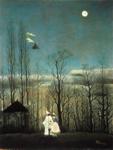
1886. Oil on canvas. 117.3 x 89.5 cm. The Philadelphia Museum of Art, Philadelphia, PA, USA.
- Promenade In The Forest.
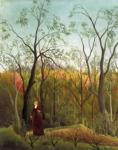
c. 1886. Oil on canvas. 70 x 60.5 cm. Kunsthaus, Zurich, Switzerland.
- Rendezvous In The Forest.
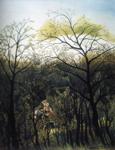
1889. Oil on canvas. 92 x 73 cm. The National Gallery of Art, Washington, DC, USA.
- View Of The Ile Saint-Louis Seen From The Port Saint-Nicolas. / Vue De...
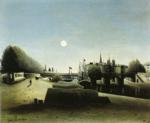
1888. Oil on canvas. 46 x 55 cm. Setagaya Art Museum, Tokyo, Japan.
- Toll Station./ L'Octroi.
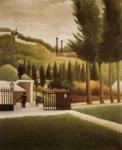
1890. Oil on canvas. 37.5 x 32.5 cm. Courtauld Institute Galleries, London, UK.
- Myself, Portrait-Landscape.
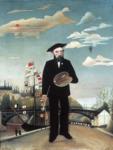
1890. Oil on canvas. 146 x 113 cm. Narodni Gallery, Prague, Czech Republic.
- Surprise!.
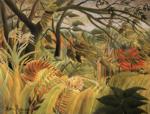
1891. Oil on canvas. 130 x 162 cm. National Gallery, London, UK.
- War.
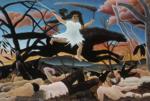
1894. Oil on canvas. 114 x 195 cm. Musée d'Orsay, Paris, France.
- A Centennial Of Independence.
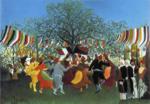
1892. Oil on canvas. 11.8 x 157.2 cm. The J. Paul Getty Museum, Malibu, CA, USA.
- The Artillerymen.
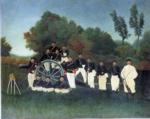
c. 1893-5. Oil on canvas. 79.1 x 98.9 cm. The Solomon R. Guggebheim Museum, New York, NY, USA.
- Portrait Of A Woman.

1895. Oil on canvas. 160 x 105 cm. Musée Picasso, Paris, France.
- Chair Factory. / Le Fabrique De Chaises.
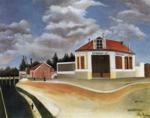
c.1897. Oil on canvas. 73 x 92 cm. Musée de l'Orangerie, Paris, France.
- Flowers./ Fleurs.
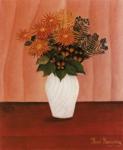
1895-1900. Oil on canvas. 61 x 50.2 cm. Tate Gallery, London, UK.
- Landscape With Cattle. / Paysage Avec Vaches.
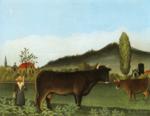
1895-1900. Oil on canvas. 60 x 65 cm. The Philadelphia Museum of Art, Philadelphia, PA, USA.